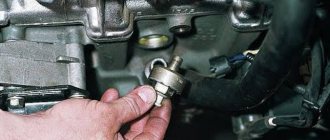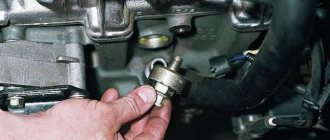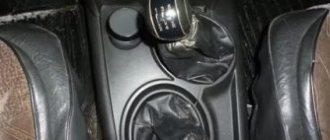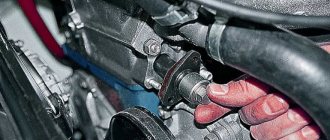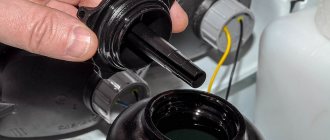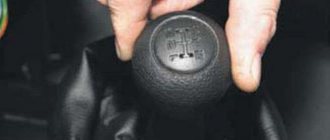Why does the Niva stall at idle (main reasons)
The Niva stalled immediately after starting, why?
Almost always, if a Niva car does not idle and stalls, the reason for this is contamination of parts, for example:
- The throttle valve, injector or carburetor is clogged.
- The idle relay has failed.
- The idle jets are dirty.
- The fuel pump is dirty.
- The engine ventilation system is clogged.
The car stalls after turning off the starter
A dirty throttle valve is to blame!
It happens that the car does not want to slow down the engine speed when you release the gas pedal or stalls at idle. Basically, the problem here lies in a clogged throttle valve. It might just jam.
This problem can happen if you constantly drive on low-quality gasoline. The damper can become clogged when contaminated air enters.
The problem can be corrected by cleaning the damper . To do this, you need to use a regular carburetor cleaner. It is sold in the store.
You should also pay attention to the clogging of the oil trap in the engine crankcase. In this case, the engine will suffocate from excess gases from the crankcase. As a result, it will not hold idle speed and stall. To eliminate the problem, you should regularly wash the crankcase ventilation filter.
The engine stalls immediately, but then starts
Idle speed regulator.
Here the reason may be in the firmware of the electronic engine control unit. The reason for this may be improperly performed tuning of the power unit. In this case, the engine will operate stably only at high speeds. If they drop below 1,000 rpm, the engine will simply stall. This malfunction can be eliminated by flashing the unit to the factory version of the program.
You should also pay attention to all kinds of sensors in car systems. These are, for example, the idle speed control, the throttle position sensor and others. They need to be checked at stands.
The carburetor is Niva’s problem
Inspection and disassembly of the carburetor.
If a carburetor , then in 4 cases out of 5 it can be the cause of unstable engine operation. The most common problem is that the carburetor is clogged. Although this unit is considered reliable in a car, it should also be cleaned periodically. It must be washed using special solvents that are sold in the store.
Carburetor contamination
The main enemy of the carburetor is low-quality fuel . Dirt and moisture can also get there from the tank. Therefore, it is recommended to regularly change the fuel filter, which is installed in front of the carburetor.
The fuel pump should be cleaned periodically. A mesh is installed on it, which traps debris.
Poor quality or old hoses through which fuel enters the tank are another reason for carburetor clogging. Such parts need to be changed every 10–15 years.
Fuel jet
It should be checked when the car stalls at idle. To check, you need to turn on the ignition and reset the wire from the EMC and reconnect it. A click should be heard. When it is not there, you should check whether voltage is supplied to it. In some cases, you will have to completely replace the part.
We carry out the adjustment ourselves
Niva 21213 can be subject to adjustment of the starting system by the gap at the edges of the valves, if the carburetor is removed, or by the crankshaft speed directly on the car. In the first case, the gap at the location of the lower edge (in the direction of air movement) from the throttle valve is set to a width of 1.1 mm.
It is adjusted with a screw that has a 0.7 cm hexagon on the head and a slot from the shank. This operation is carried out with the cam lever turned counterclockwise from the starting system control (all the way). In the same position, the gap at the lower edge of the air damper is set to 3 mm using a screw in the cover from the diaphragm mechanism in the starting system (you need to loosen the lock nut).
Adjusting the Niva starting system directly in the car saves time:
- You need to remove the air filter from the engine, pull the control lever away from the air damper, and start the engine.
- When the air damper is forcibly opened (by touching a flat screwdriver to a third of its full angle of rotation) using a screw (next to the lever on the axis from the throttle valve from the first chamber), the initial rotation speed is set to 2.08.mar.0 thousand rpm (on a warm engine).
- Remove the screwdriver, lower the air damper and, using the screw stop (next to the diaphragm), set the frequency to be 100 rpm lower than the original one (you need to select the appropriate position of the air damper).
- The screw can then be secured using a locknut.
If you have a gas analyzer, then the carburetor adjustment in the starting system part can be done based on the amount of CO (carbon monoxide) in the exhaust gases. If, with the choke control lever fully extended, the gas rate is 8%, then everything is in order. If there is less gas than this value, then the screw on the cover of the diaphragm mechanism is tightened; if there is more, it is unscrewed and repeated measurements are taken.
It is necessary to adjust the idle speed of the Niva 2121 so that there is less carbon monoxide in the exhaust gases and so that the engine runs stably. At service stations, such work is carried out with gas analyzers on the MV. In the garage, adjustments can be made using the tachometer.
Also interesting: Overheating of VAZ-21213 and VAZ-21214 engines on Lada Niva and Lada 4x4
For these purposes, on a warm engine, a plastic plug is pierced with a screwdriver, then the quality screw is rotated in different directions until the maximum idle speed is reached. Then, using the quantity screw (has a ribbed plastic handle), you need to set an increased speed (50-70 rpm more than at standard idle speed).
Carburetor car engine starts and stalls
In this article we will take a closer look at the situation when a carburetor engine of a passenger car (VAZ 2108, 2109, 21099, 2105, 2107 and their modifications) starts and stalls due to a carburetor malfunction.
Malfunctions of carburetors 2105, 2107 Ozone, 2108, 21081, 21083 Solex and their modifications will be considered. — The engine starts, runs for a few seconds and stalls, repeated starts are unsuccessful.
— The engine starts with difficulty, after running for a short time it stalls, after restarting it starts and runs.
— The engine starts and immediately stalls, starts again and stalls again, and so on several times, but then it still starts working.
Causes of the malfunction “carburetor engine starts and stalls”
There is no fuel in the float chamber
Pump it up using the manual pump lever on the fuel pump.
The fuel pump or power system may be faulty. Remove the hose from the carburetor fuel supply fitting and press the manual primer lever on the fuel pump several times. A strong pulsating stream of gasoline should come out of the hose hole. If it is missing or weak, check the fuel pump or power system.
Checking the VAZ fuel pump
The strainer at the carburetor inlet is clogged
Remove it by unscrewing the cap, clean it (you can use a toothbrush), rinse with acetone or gasoline and blow with compressed air. At the same time, clean the filter seat in the carburetor cover.
Details of strainer filters for fuel purification of carburetors 2108, 21081, 21083 Solex, 2105, 2107 Ozone
The solenoid valve is faulty or the fuel jet of the idle system is clogged
Check whether the solenoid valve or the idle air system fuel nozzle holder has become loose due to any circumstances. Turn it on. Remove the wire from the valve and then put it back on. You should hear the click of the valve being activated. If it is not there, we connect a piece of wire plus the battery and the valve outlet. There is no click - we change the valve. There is a click - we check the EPH system.
Solenoid valves for carburetors 2108, 21081, 21083 Solex, 2105, 2107 Ozone
Check the serviceability of the valve itself by unscrewing it from the carburetor and removing the fuel jet from it. The jet should be carefully inspected for contamination and deformation. We also check the ease of movement of the valve shut-off needle, the presence and integrity of the rubber O-ring on the valve body.
Carburetor solenoid valve design
Unscrew the idle air system fuel nozzle holder (on carburetors with a holder instead of a solenoid valve), rinse, clean the fuel nozzle and blow with compressed air.
“Suction” of foreign air into the carburetor
In this case, the fuel mixture is lean. If the engine starts and immediately stalls, it is most likely very lean. The image shows probable places where foreign air is “sucked in” on the 2108 Solex carburetor.
Places of possible “suction” of foreign air into the carburetor 2108, 21081, 21083 Solex
Read more about the “suction” of foreign air in the article “Suction of foreign air into the carburetor.”
Trigger diaphragm damaged or out of adjustment
Disassemble the starter housing and replace the diaphragm with a new one. Adjust the starting device.
Starting devices for carburetors 2108, 21081. 21083 Solex, 2105, 2107 Ozone
Fuel and air jets, emulsion wells and tubes of the main dosing system are clogged
It is necessary to remove the carburetor cover, unscrew the jets, remove the tubes, rinse and clean them, clean the wells, blow everything out with compressed air and put it back. The image shows what should be cleaned on the carburetor 2105, 2107 Ozone.
On the Solex carburetor, unscrew the air jets and take them out along with the emulsion tubes. At the bottom of the opened wells there are fuel jets. We turn them out with a thin long slotted screwdriver. Clean, rinse with acetone and blow with compressed air.
Fuel and air jets, emulsion tubes and emulsion wells of GDS carburetors 2108, 21081, 21083 Solex, 2105, 2107 Ozone
Fuel and air jets and idle system channels are clogged
Unscrew the jets, rinse and clean them, and blow them with compressed air.
Air and fuel jets for CXX carburetors 2108 Solex and 2105, 2107 Ozone
You can try to clean the idle system without disassembling the carburetor. Here is an article on this topic “Cleaning the idle system of the carburetor 2108, 21081, 21083 Solex.”
The fuel level in the carburetor float chamber is broken
The fuel mixture is either very lean or very rich due to incorrect adjustment.
Approximate fuel level in the float chambers of carburetors 2108, 21081, 21083 Solex, 2105, 2107 Ozone
Articles on the site about adjusting the fuel level:
The carburetor air damper drive is not adjusted (“choke”)
A not fully open air damper causes the fuel mixture to become richer in some cases to such an extent that it is difficult to start the engine, especially when it is hot. The spark plugs may become flooded with fuel. Adjust the drive:
With the choke handle fully extended, the air damper should completely cover the cross-section of the first chamber of the carburetor.
The air dampers of carburetors 2108, 21081, 21083 Solex, 2105, 2107 Ozone are completely closed
With the handle fully recessed, the air damper should be strictly vertical.
The air dampers of carburetors 2108, 21081, 21083 Solex, 2105, 2107 Ozone are completely open
Notes and additions
— Before searching for the reasons that a carburetor engine starts and stalls, it is recommended to check the serviceability of the ignition system, since the symptoms of its malfunction are similar to the symptoms of a malfunction of the ignition system and the presence of fuel supply through the power system.
More articles on the site on carburetor malfunctions
Models of carburetors on VAZ 2121 Niva cars
The 2121 is equipped with Ozone carburetors. These mechanisms are divided into only two types:
2107–110–7010–10 (equipped with an old-style breaker, does not have a vacuum corrector);
2107–110–7010–20 (a more modern model, however, due to the absence of a microswitch from the economizer, it has increased fuel consumption).
“Ozones” have a structure and operating principle that is traditional for carburetor units.
The equipment unit for VAZ 2121 cars has a design traditional for carburetors
Engine stalls without choke, stalls when cold
- Go to page:
Engine stalls without choke, stalls when cold
Post by bregovich » Nov 20, 2010, 11:54 pm
Re: Engine stalls without choke
Post by Ghost_killer » Nov 20, 2010, 11:58 pm
Re: Engine stalls without choke
Post by WhiteUnicorn » 21 Nov 2010, 01:20
Re: Engine stalls without choke
Post by Portada » 21 Nov 2010, 19:00
Re: Engine stalls without choke
Post by bregovich » Nov 21, 2010, 11:23 pm
Re: Engine stalls without choke
Post by Portada » Nov 21, 2010, 11:47 pm
Re: Engine stalls without choke
Post by WhiteUnicorn » 22 Nov 2010, 00:22
Re: Engine stalls without choke
Post by Portada » 22 Nov 2010, 00:25
Re: Engine stalls without choke
Post by ALK » 22 Nov 2010, 00:35
Who knows what's going on behind the fence of the zoo? ©
Re: Engine stalls without choke
Post by Egorych 31 » 29 Nov 2010, 23:06
Re: Engine stalls without choke
Post by ALK » Nov 29, 2010, 11:39 pm
heating from the exhaust manifold?? theoretically - yes, the air mass has become larger.
did the EPHH valve, as written above, change?? Does it also stall when you let off the gas?
Who knows what's going on behind the fence of the zoo? ©
Re: Engine stalls without choke
Post by Portada » Nov 29, 2010, 11:40 pm
Re: Engine stalls without choke
Post by Pasha » November 30, 2010, 10:48 am
Egorych 31
I have the exact same story. It started last winter - the carb was blowing, I adjusted the idle, but it didn't work. then I covered the radiator completely with cardboard and everything was fine
Now I want to try to install an electric fan, but I don’t have the money yet, and the cold weather is approaching.
And even in the summer, in traffic jams when the temperature rises above 90, the XX also starts to float and stalls
Re: Engine stalls without choke
Post by Egorych 31 » 30 Nov 2010, 21:58
Pasha I didn’t understand anything. Why is there a cardboard, the car doesn’t freeze, it’s warm in the cabin, the antifreeze temperature is 90. If I put the cardboard in, it might start to warm up, why do I need the cardboard? here is the corrugation - yes, it may be needed in winter for the carb, it may be cold.
Chew it on me, I haven’t had a Lada for a long time
Injectors
Fuel is injected into the cylinders through electromagnetic injectors. Due to poor quality fuel, they can become clogged and not allow enough fuel into the cylinder. Hence we have the fact that the car stalls when the gas is released. The injectors are installed on the fuel rail. Everything can be easily removed, and you can carry out the injector cleaning procedure yourself in your garage. You just need to first buy new rubber gaskets for the injectors and carburetor flushing fluid. We put the wires from the battery on the nozzle and supply liquid from a can of cleaner into it under pressure through a standard tube. It is necessary to achieve good atomization of the liquid coming out through the nozzle; when voltage is applied from the battery, the nozzle should click. If this does not happen, then it must be replaced. But it’s better to contact a service center that has the necessary equipment and will do the washing procedure much better.
The car sometimes stalls at idle, carb
- Thank you
- I do not like
KuDeSNIK March 10, 2008
Carburetor engine, 1.8 l, carburetor costs 73rd. At times the car idles perfectly, and at times it stalls, but not immediately, but when it drops the revs to 500 rpm and makes a couple of revolutions, it stalls. The manifestation of the defect does not depend on the engine temperature. What has been done: 1. The distributor has been replaced (contactless system), the ignition has been adjusted (even with a strobe light). The high-voltage wires were ringed and checked “in a circle” by replacing them with a serviceable one from another set. The spark is normal. 2. The valves have been adjusted. 3. The carb was removed, purged and inspected. There is no large output, the membranes (acceleration and power modes) have been replaced with new ones (although there was no particular need). The throttle valves close normally (this was the case initially: the main other valve “sharpened” a ledge that prevented free full closing, this was eliminated by inserting a washer, which removed the backlash and the valve closes normally, the “clearance” gaps are normal). It holds idle (no defects appear) even with the screw for adjusting the mixture quality fully tightened (who knows: in this carb it only blocks the additional groove; gasoline still flows through the main one, i.e. fully tightening the screw does not mean completely shutting off the fuel supply) . 4. The solenoid valve with the jet was replaced (for some reason the jet was marked 39, now it’s 41). The valve clicks, the electronics are tested according to the procedure. It was also tested with a jumper 4-6 pins in the connector, i.e. Constantly forcing the fuel supply through this very valve did not help. 5. It was discovered that when the tube to the vacuum brake booster is closed, the defect disappears! The brake hose and vacuum booster were replaced (with new ones). 6. The afterburning or officially “recirculation” system is completely turned off and turned off (this is a gadget about which they say that it still doesn’t work properly, everyone turns it off). This is what connects the exhaust and intake manifolds. At the same time, it was checked whether the elements of the system hold a vacuum - they do. 7. Linings under the carb without signs of leakage, in good condition.
Observations: as I wrote, the manifestation of a defect does not depend on the engine temperature. Perhaps only from using the brake. Immediately after releasing the brake pedal, the engine makes a short-term increase in revolutions by 100-200. Sometimes, after several presses of the brake pedal (and, accordingly, jumps in revolutions), the defect disappeared and the revolutions were set to even (about 1000, well, how high it was). Also, when the defect appeared when accelerating (and at the same time the engine works great - it pulls, doesn’t sneeze), there was a “strumming” as if it was too advanced.
Need advice: what ELSE should you see? Very similar to “vacuum” problems, since it affects the ignition timing, but where? All “white tubes” are normal.
Electrical part
Pay attention to the distributor, ignition coil and high-voltage wires. Take measurements on the wires (for breaks) using an ohmmeter or a test light. If the light bulb does not glow, look for a broken wire.
Ballast resistance can also cause the engine to rev poorly. The ribbed block under the windshield is ballast resistance. If you discover a fault in the ballast resistor, you need to replace it immediately, since it cannot be repaired (you can, of course, try to repair it in a specialized workshop).
Check the distributor body for mechanical damage, chips, and carbon contacts of the central electrode. Check the resistance of the spark plug tips with an ohmmeter. If the problem persists, try adjusting the ignition timing. Having set the distributor to the neutral position, slowly turn it left/right - the engine operation will change.
One of the reasons why the engine does not develop speed is the fuel system.
In the fuel supply system for gasoline engines, one of the main roles is played by the gasoline pump. You should also check the fuel filter (if necessary, replace it). The filter may not allow fuel to pass through due to the presence of water or mechanical impurities in it.
of a diesel engine depends on the operation of the fuel equipment and injectors. Failure of injector nozzles or plunger pairs of the fuel pump affects engine power, to the point where the engine does not start at all.
Also make sure that there are no fuel leaks in the fuel system. If fuel leaks, look for the cause in a leak. The fuel filter of a diesel engine in the summer may not allow diesel to pass through due to the water that has accumulated in the filter, and in the winter, due to the use of low-quality winter fuel, there may be paraffin deposits on it, so it should be changed.
Read news about the new Niva
- Bear tires: price, sale of Medved tires, catalog, buy in Moscow
- Tire pressure - OLX.kz
- Is it possible to drive on mud tires in winter? — Do-it-yourself car diagnostics and repairs
- Replacing the Niva Chevrolet heater fan: why it doesn’t work, creaks, do-it-yourself repairs » AvtoNovator
- Causes and remedies for engine overheating
- Niva Chevrolet installation of air conditioning – Auto magazine MyDucato «
- Interchangeability of all spark plugs and analogues
- Diagnostics of Chevrolet Niva suspension in Vladimir: addresses and phone numbers of car services, ratings and reviews, questions and answers




